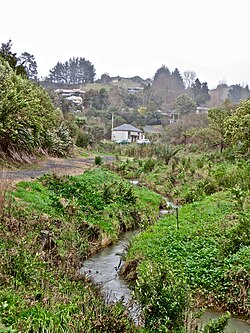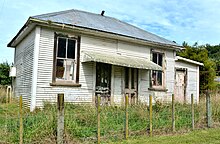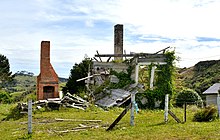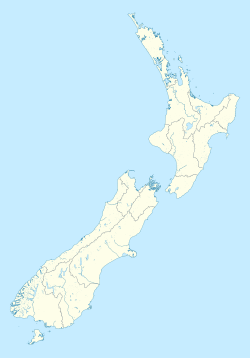Glen Massey
Glen Massey | |
|---|---|
Village | |
 Stream, former rail track and former medical centre in 2014 | |
| Coordinates: 37°40′20″S 175°04′23″E / 37.67222°S 175.07306°E | |
| Country | New Zealand |
| Region | Waikato region |
| District | Waikato District |
| Elevation | 100 m (300 ft) |
| Population (2013 census) | |
• Territorial | 237 |
| Time zone | UTC+12 (NZST) |
| • Summer (DST) | UTC+13 (NZDT) |
Glen Massey is a former mining village, 9.5 km (5.9 mi) west of Ngāruawāhia, which was, until 1958, terminus of the Glen Massey Line. It then went into decline, but is now becoming a home for Hamilton commuters.
Name
[edit]There is no official name.[1] Various names appeared on maps and in reports of the area.
Mangahoa is the only name in the area shown on an 1859 map,[2] probably applying to what was later called the Mangaohe Stream,[3] called Mangaohei in an 1867 report,[4] and used on maps up to 1966,[5] but officially named Firewood Creek in 1976.[6] As early as 1909 a report referred to Firewood Creek.[7]
Kupa Kupa was the name used at the 1860s compensation hearings for the 9,280 acres (3,760 ha)[8] area north of Te Awa o te Atua[9] (River of God[10] - now Firewood Creek), and stretching to what is now Huntly,[11] as it included the former village of that name near Huntly.[12]
Te Akatea (translates to white rata, which was plentiful) village settlement of 22 settlers was formed in 1887,[13] spread along much of the route between Ngāruawāhia and Waingaro. The name is still retained by a hamlet about 4 km (2.5 mi) north of what is now Glen Massey.[14]
Glen Massey seems to have first appeared in 1914.[15] One source asserts there was a large Scottish population in the area, the name ‘Glen’ means ‘valley’, and the name ‘Massey’ honoured the Prime Minister, William Massey, elected in 1912.[16]
Geology
[edit]
The geology of Glen Massey accounts for its rise and fall as a former coal mining centre.
The 1925 map below shows a simple layout. Since then, maps of 1966[5] and 2005[17] have differentiated more strata, as in this list, starting with the oldest rocks -
Triassic (L on the map - 250-200mya), in the Newcastle Formation. They are -
- Hakarimata Formation of indurated siltstones and tuffaceous sandstones, with other siltstones and conglomerates,
- Marakopa Formation, containing intraformational slump structures and shell-beds.
Jurassic (T - 200-145mya)
- Te Pake Sandstone, with plant fragments,
- Pongawhakatiki Siltstone of Ururoan age, another indurated rock.
Eocene (CM - 33-27mya)[18] Waikato coal measures[19] (see next section).
Oligocene (K - late Whaingaroan - 30mya) Glen Massey Formation, named after this locality -
- Elgood Limestone (with up to 95% CaCO3), hard flaggy, grey calcareous
- Dunphail Siltstone (outcropping in Dunphail Bluffs, with up to 60% CaCO3)
- Ahirau Sandstone bluffs (with 40-60% CaCO3).[20]
The Late Pliocene to Middle Quaternary (3.6-0.8mya) in the lowlands -
- Walton Subgroup of pumiceous fine-grained sand and silt with interbedded peat, pumiceous gravelly sand, diatomaceous mud, and non-welded ignimbrite and tephra.[21]
The Late Pleistocene (0.13-0.012mya) also in the valleys -
- Hinuera formation of sand and gravel, interbedded with silt and some peat.[22]
Coal mining
[edit]Although the Kupakupa, Renown and Kemps Seams are all present, only Kupakupa has been worked to any extent. Kupakupa Seam reserves are estimated at less than 40 000 tonnes, although 2m tonnes may be concealed under the northern area, and over 1m in 'sub-economic' seams of the old Waipa Colliery.[23]
The beds are in a graben and dip gently N or NW. Major faults strike N or NNW and minor faults NE.[23]
Glen Massey's coal was known of by 1867, when it was suggested a tramway should be built down the Mangaohei valley.[4] However, seams closer to river transport were available, so no significant exploitation began until 1907.
Between 1914 and 1977 about 3.5m tonnes of coal were dug in the Glen Massey coalfield,[24] as follows -[25]
| Open | Close | Colliery | Type | Tons |
|---|---|---|---|---|
| 1914 | 1930 | Waipa | mine | 1,071,346 |
| 1930 | 1958 | Wilton | mine | 2,033,232 |
| 1944 | 1949 | Kemps | open | 239,340 |
| 1948 | 1948 | Heworth | mine | 505 |
| 1949 | 1950 | Hillcrest | mine | 54,073 |
| 1952 | 1961 | Hunters | mine | 6,794 |
| 1952 | 1952 | Dunphail | open | 945 |
| 1962 | 1969 | Hughes | mine | 40,412 |
| 1967 | 1968 | Hughes | open | 2,468 |
| 1970 | 1973 | McDougall 1 | open | 9,853 |
| 1972 | 1973 | McDougall 2 | open | 15,433 |
| 1973 | 1974 | McDougall 3 | open | 6,998 |
| 1974 | 1977 | McDougall 4 | open | 5,552 |
A 1976 estimate said 30,000 tons might remain in the coalfield, but a 1984 report suggested it was too deep for economic opencasting.[25]

Waipa Colliery
[edit]In 1907 a request was made to transport coal by motor vehicle[26] and, in 1908, the Ngaruawahia Dairy Association took 3 tons of coal a week from the seams that were to become Waipa Colliery,[25] during a strike at Huntly mines.[27] A start was made on a tramway in 1908,[28] soon described as a light railway[29] for the Co-operative Coal Co Ltd, set up by 3 farmers,[30] soon renamed Ngaruawahia Coal Co Ltd.[31] and merged into Waipa Railway and Collieries Ltd.[32] An adit into an 11 ft (3.4 m) seam had been started by 1911.[33]
Clay
[edit]The China Clay and Porcelain Co Ltd was formed in 1924 to export china clay and make bricks, tiles and bathroom-ware. It probably only made bricks in any quantity.[25] It went into voluntary liquidation in April 1930.[34]

History
[edit]
The archaeology map shows no sites between Ngāruawāhia and Waingaro,[35] though many stone axe heads were found on nearby Te Akatea farm, which was largely bush until it was burnt after 1905.[36] Therefore, it's likely the area was largely bush until the arrival of the first settlers, being used by the surrounding populations for food and clothing, including birds, bracken, karaka, hinau, nīkau, kahikatea, raupo, kiekie; flax, dyes from muds, bark, or berries and oils from seeds such as titoki.[37]

Te Akatea settlement
[edit]After confiscation in 1863,[9] the area was next mentioned in 1879 as not belonging to the Waste Lands Board.[38] At Te Akatea, in 1887, a village settlement of 22 families was formed.[13] An 1888 report said, "I determined when opportunity presented to see if the solution of the problem here was to be a success. These settlements extend from Firewood Creek to within 7 miles of the Hot Springs, and about the same distance from Ngāruawāhia. The land being of fair quality, consisting of both bush and open fern land. They erected 12 timber houses, felled bush, sown grass, orchards, gardens, fenced, grew wheat. Around this settlement 20,000 acres of Government land are now being surveyed for settlement."[39] Te Akatea post office opened in 1889.[40] The first mention of Te Akatea in the annual sheep returns was in 1891.[41]
Mining village
[edit]At its peak Glen Massey had a general store, butcher, post office (replacing Te Akatea in 1914),[42] hall, church and a fire station.[43] The medical association had 120 members in 1919[44] and 90 in 1920.[45]
A 1919 Board of Trade report described Glen Massey's poor housing, saying it, "is totally inadequate for the needs of the workers, and overcrowding exists. In one case, a miner, with his wife and five children, is living in a two-roomed cottage, and in another ease there are five persons (three children) living in two rooms. At least 10 roomy houses are required for immediate needs. The huts provided by the Waipa Company at present have no fire-places or water tanks, and both these necessary conveniences should be provided."[46]
The village also had a sawmill, brickworks and a pottery. The butcher closed in 1962, the store in 1967 and the post office in 1984.[25]
Roads
[edit]
By 1886 there was a route between Waingaro Landing on the Raglan Harbour and Ngāruawāhia via the Waingaro Hot Springs.[43] In 1888 it was still only a bridle track and the settlers were asking for government employment on the roads.[39] By 1929 it was said to be in "fair order" and metalled. Road improvement is being carried out.[47] relief work on the road.[48] inspected by minister.[49] The road from Ngāruawāhia to Te Ākau was sealed by 1976.[13]
Buses
[edit]In 1921 Bob Gibb of Ngāruawāhia took over the mail run to Waingaro and Te Akau and cream run to the Ngāruawāhia butter factory, with a solid tyred International.[50] Daily buses ran from 1930[51] until between 1958 and 1961.[25]

Education
[edit]The first school in Waingaro was opened in 1892. Education was for 3 days, the other 3 days of the week was given by the same teacher at Te Akatea. Te Akatea School was renamed Glen Massey School in 1914,[52] when the church was moved across the road for use as a school, a marquee was erected and the permanent school opened on 1 February 1915.
Glen Massey School is now a state full primary (years 1-8) school,[53] with 5 classrooms,[16] 6 teachers, a principal, a deputy principal, special needs teacher and 2 teacher aides.[16] Pupil numbers rose from 58 in 1915 to a peak of 146 and 4 teachers in 1957, falling to 64 in 1960.[16] The school had a roll of 121 as of November 2024.[54] In the 2018 Education Review Office report, a third of the students were Māori.[55]
Utilities
[edit]A private telephone line was being planned in 1914,[56] though a public phone was provided that year[15] and arrangements were being made for a line in 1902.[57] The 1905 estimates had provided for a line from Ngāruawāhia to Waingaro,[58] on which a loss was reported in 1907.[59]
Electricity supply was investigated in 1925[60] and, in 1930, it was said a line to Wilton Collieries and the village, "would be undertaken as early as possible".[61] Electric street lights came in 1936.[62]
Demographics
[edit]At its peak Glen Massey was home to about 400,[25] but declined after the colliery closures. It is now growing slightly and becoming more prosperous, presumably as, like other parts of the Waikato Western Hills area (up from 1026 in 2006 to 1242 in 2013), it has more commuters to Hamilton.[63] In 2013 19.6% of the Western Hills population was Māori.[64]
Glen Massey was in meshblocks 0853300 (NW), 0853400 (NE), 0853500 (SW) and 0853600 (SE), which had these census figures[65] -
| Population | Households | Average income | National average | ||||||||||||
|---|---|---|---|---|---|---|---|---|---|---|---|---|---|---|---|
| Year | NW | NE | SW | SE | total | NW | NE | SW | SE | total | NW | NE | SW | SE | |
| 2001 | 66 | 42 | 27 | 93 | 228 | 21 | 18 | 12 | 33 | 84 | $14,200 | $12,500 | $21,300 | $14,400 | $18,500 |
| 2006 | 57 | 39 | 39 | 114 | 249 | 21 | 15 | 15 | 39 | 90 | $20,400 | $13,300 | $27,500 | $20,400 | $24,100 |
| 2013 | 81 | 30 | 36 | 90 | 237 | 27 | 15 | 15 | 36 | 93 | $28,300 | $36,300 | $62,500 | $32,500 | $27,900 |
In the 2018 census the area was in blocks which covered a larger area - 7011120 (99 people), 7011117 (150) and 7011124 (165) - total 414.[66]
References
[edit]- ^ "New Zealand Gazetteer: Search for Place Names". Land Information New Zealand (LINZ). Retrieved 4 February 2018.
- ^ "The southern part of the province of Auckland : explanatory of the routes and surveys by Dr. Ferdinand von Hochstetter, 1859 / from the original drawings, sketches and measurements by Dr. von Hochstetter and the Admiralty surveys by Stokes and Drury compiled by A. Petermann". ndhadeliver.natlib.govt.nz. Retrieved 4 February 2018.
- ^ "Current and historical topographic maps (topomaps) of New Zealand". www.mapspast.org.nz. Retrieved 3 February 2018.
- ^ a b "The Daily Southern Cross". 18 December 1867. p. 3. Retrieved 3 February 2018.
- ^ a b "Ngaruawahia geological survey 1:63,360". University of Waikato. 1966.
- ^ "New Zealand Gazetteer: Search for Place Names". Land Information New Zealand (LINZ). Retrieved 15 April 2018.
- ^ "A New Industry in Hamilton". Waikato Argus. 27 August 1909. p. 2. Retrieved 5 February 2018.
- ^ "Appendix to the Journals of the House of Representatives | 1865 Session I Return of land taken under "The New Zealand Settlements Act, 1863."". paperspast.natlib.govt.nz. Retrieved 3 February 2018.
- ^ a b Taonga, New Zealand Ministry for Culture and Heritage Te Manatu. "Confiscation map, 1869". teara.govt.nz. Retrieved 3 February 2018.
- ^ "The Ancient History of the Maori, His Mythology and Traditions: Tai-Nui. [Vol. IV] Chapter III". nzetc.victoria.ac.nz. 1888. Retrieved 3 February 2018.
- ^ "Page 5 Advertisements Column 1". New Zealand Herald. 5 October 1866. p. 5. Retrieved 3 February 2018.
- ^ "Routes and surveys in the southern part of the Province of Auckland by Ferdinand von Hochstetter, 1859". Kura Heritage Collections Online (Auckland Libraries). Retrieved 9 December 2024.
- ^ a b c CW Vennell & Susan Williams (1976). Raglan County Hills and Sea 1876–1976. Wilson & Horton for Raglan County Council. ISBN 978-0868640020.
- ^ "Te Akatea, Waikato - NZ Topo Map". NZ Topo Map. Retrieved 2 February 2018.
- ^ a b "Glen Massey Notes". Waikato Times. 15 May 1914. p. 4. Retrieved 4 February 2018.
- ^ a b c d Retter, Lauren (November 2013). "Glen Massey School: A History from 1887 The New Zealand Journal of Public History Volume 2, No. 1" (PDF). University of Waikato.
- ^ "1:250,000 geological map Waikato". IGNS. 2005. Archived from the original on 21 July 2018. Retrieved 27 February 2018.
- ^ Steven L. Hall, Andrew Nicol, Tim A. Moore & Kari N. Bassett (2006). "Timing of normal faulting in the Waikato Coal Measures, New Zealand, and its implications for coal-seam geometry". New Zealand Journal of Geology and Geophysics. 49: 101–113. doi:10.1080/00288306.2006.9515151. S2CID 128746235.
{{cite journal}}: CS1 maint: multiple names: authors list (link) - ^ Kear, David (1967). "Economic Geology of the Waikato" (PDF). Earth Science Journal.
- ^ New Zealand Journal of Geology and Geophysics. The Royal Society of New Zealand. 1959.
- ^ EDBROOKE, S. W. "Geology of the Waikato Area 1:250 000 geological map 4". Institute of Geological & Nuclear Sciences. Archived from the original on 21 July 2018. Retrieved 27 February 2018.
- ^ Nigel Edger, Opus International Consultants. "HOROTIU LANDFILL STAGE 6B: DESIGN, CONSTRUCTION & CONSTRUCTION QUALITY ASSURANCE" (PDF).
- ^ a b "Waikato coalfields : Glen Massey Coalfield. Scale 1:15,840". GNS Online Shop. Retrieved 2 February 2018.
- ^ New Zealand Geological Survey (1988). "Summary of coal resources - Waikato coal region". University of Waikato.
- ^ a b c d e f g Jones, Gwyneth (2010). The end of an era: the history of the coalmines and village of Glen Massey and the surrounding districts. OCLC 870958566.
- ^ "County Councils". New Zealand Herald. 29 July 1907. p. 7. Retrieved 5 February 2018.
- ^ "Country News". New Zealand Herald. 12 February 1909. p. 8. Retrieved 5 February 2018.
- ^ "Waikato Argus". 1908. p. 2. Retrieved 5 February 2018.
- ^ "A New-Coal-Mine". Auckland Star. 30 April 1908. p. 5. Retrieved 5 February 2018.
- ^ "Coalfield at Te Akatea". Waikato Argus. 4 June 1908. p. 3. Retrieved 5 February 2018.
- ^ "Mining News". New Zealand Herald. 12 August 1908. p. 5. Retrieved 5 February 2018.
- ^ "Waikato Argus". 23 October 1909. p. 2. Retrieved 5 February 2018.
- ^ "Waipa Collieries". Auckland Star. 17 October 1910. p. 6. Retrieved 6 February 2018.
- ^ "China Clay and Porcelain Co. Ltd". Auckland War Memorial Museum.
- ^ "NZAA Site Viewer". nzaa.eaglegis.co.nz. Archived from the original on 26 June 2009. Retrieved 5 December 2015.
- ^ Farms and Stations of New Zealand, Etc. (Editor, G.A. Tait. Associate Editor, Keitha M. Alison.-vol. 3. Assistant Editor, L. Higgins.) [With Illustrations.]. Auckland. 1957.
- ^ "Maori customary use of native birds, plants & other traditional materials" (PDF). DoC. 1997.
- ^ "Waste Lands Board". New Zealand Herald. 1879. p. 6. Retrieved 3 February 2018.
- ^ a b "Te Akatea Village Settlement". Waikato Times. 19 June 1888. p. 2. Retrieved 30 January 2018.
- ^ "F-01 Post Office and Telegraph Department. (report of the) for the Year 1889". Appendix to the Journals of the House of Representatives – via Papers Past.
- ^ "Parliamentary Papers | Appendix to the Journals of the House of Representatives | 1891 Session II The annual sheep returns for the year ended 30th April, 1891". paperspast.natlib.govt.nz. Retrieved 3 February 2018.
- ^ "Country News". New Zealand Herald. 2 July 1914. p. 10. Retrieved 29 January 2018.
- ^ a b "Glen Massey Community Plan 2007–2017" (PDF). Waikato District Council.
- ^ "Glen Massey Medical Assn". Waikato Times. 10 October 1919. p. 4. Retrieved 29 January 2018.
- ^ "Waikato Hospital Board". Waikato Times. 19 November 1920. p. 6. Retrieved 29 January 2018.
- ^ "Miners' Homes". Sun. 26 June 1919. p. 3. Retrieved 29 January 2018.
- ^ "On the Roads". Auckland Star. 22 February 1929. p. 9. Retrieved 29 January 2018.
- ^ "Unemployed Relief". Auckland Star. 26 December 1930. p. 5. Retrieved 29 January 2018.
- ^ "Tour in Waikato". New Zealand Herald. 18 June 1934. p. 10. Retrieved 29 January 2018.
- ^ Seavill, Geoffrey. PACK HORSE TO JET the story of Waingaro from 1868.
- ^ "Regional Planning". New Zealand Herald. 10 May 1930. p. 13. Retrieved 29 January 2018.
- ^ "Board of Education". Waikato Argus. 1 October 1914. p. 2. Retrieved 29 January 2018.
- ^ Education Counts: Glen Massey School
- ^ "New Zealand Schools Directory". New Zealand Ministry of Education. Retrieved 1 January 2025.
- ^ "Glen Massey School - 14/12/2018". Education Review Office. Retrieved 23 August 2019.
- ^ "The Waikato Times. Monday, June 29, 1914. Day by Day". Waikato Times. 29 June 1914. p. 4. Retrieved 29 January 2018.
- ^ "Raglan County Council". Waikato Times. 28 November 1902. p. 2. Retrieved 7 March 2018.
- ^ "Parliamentary Papers | Appendix to the Journals of the House of Representatives | 1905 Session I Public works statement. by the hon. w. hall-jones, minister for public works, 29th August, 1905". paperspast.natlib.govt.nz. Retrieved 3 February 2018.
- ^ "Raglan County Council". Waikato Argus. 25 July 1907. p. 2. Retrieved 5 February 2018.
- ^ "Ngaruawahia News". New Zealand Herald. 28 September 1925. p. 7. Retrieved 29 January 2018.
- ^ "Hydro-Electric Power". New Zealand Herald. 15 May 1930. p. 7. Retrieved 29 January 2018.
- ^ "Power Board Affairs". New Zealand Herald. 12 November 1936. p. 15. Retrieved 29 January 2018.
- ^ "SNZ Commuter View". archive.stats.govt.nz. Retrieved 5 February 2018.
- ^ "2013 Census QuickStats about a place". Retrieved 6 February 2018.
- ^ "2013 Census map – QuickStats about a place". archive.stats.govt.nz. Retrieved 29 January 2018.
- ^ "Data | SA1 | Census | 2018 | SA1 Dataset | GIS Map Data Datafinder Geospatial Statistics". datafinder.stats.govt.nz. Retrieved 19 September 2021.
External links
[edit]- 1:50,000 map
- 1925 geological map
- Reglan to Kawhia map, circa 1860
- Google street scene at former railway crossing (a short path follows the old track)
Photos -
- 1914 Conveying of the coal from the mine to the bins with trucks travelling on an endless cable tramway at the Waipa Collieries near Ngāruawāhia
- incline, screening bins and recently felled/burnt bush
- https://kura.aucklandlibraries.govt.nz/digital/collection/photos/id/201554 1914 A new coal mine in the Waikato]
- Waipa Colliery at closure in 1930 and coal train
- 1940s aerial view of Wilton Collieries
- 1941-1979 Retrolens aerial views

